The importance of high-quality headphones cannot be overstated in the intricate world of music production, where every detail counts.
Having the right tools at your disposal is critical to achieving professional-grade results, whether you’re a seasoned producer or an aspiring artist venturing into the world of mixing and mastering. The headphones you select are one such tool that frequently takes center stage in this process.
While headphones have become a common accessory for music fans, not all of them are created equal when it comes to the intricate tasks of mixing and mastering.
Regular consumer headphones may be adequate for casual listening, but they fall short of the requirements for accurate sound representation, precise frequency response, and the meticulous analysis required for audio perfection.
We’ll delve into the world of mixing and mastering headphones in this comprehensive guide. We’ll dissect the details that distinguish them from standard headphones, focusing on the key factors that demand your attention during the selection process.
Whether you’re a producer looking to expand your sonic arsenal or an artist looking to ensure your music sounds great across multiple platforms, this guide will provide you with the information you need to make an informed decision.
Stay tuned as we dispel the myths surrounding the best headphones for mixing and mastering, allowing you to maximize the potential of your music production journey.
The Ultimate Guide to Mixing and Mastering Headphones
In this Topic we will cover:-
- Understanding Mixing and Mastering Headphones
- Key Factors to Consider
- Best Headphones for Mixing and Mastering
- Additional Tips for Successful Mixing and Mastering
1. Understanding Mixing and Mastering Headphones
Before we get into the specifics of choosing the best headphones for mixing and mastering, it’s important to understand what sets these headphones apart from their consumer-grade counterparts.
The final stages of the music production process are mixing and mastering, where minute details can make or break the overall quality of a track. Let’s look at the details that distinguish mixing and mastering headphones:
Accuracy and precision:
Unlike regular headphones, which frequently emphasize bass or treble to improve the listening experience, mixing and mastering headphones place a premium on accuracy.
They want to provide a neutral and uncolored representation of the audio so that producers and engineers can hear every detail exactly as it is. This precision is critical for detecting flaws, balancing elements, and making fine adjustments.
Frequency Response is Flat:
Mixing and mastering necessitate a thorough understanding of how various frequencies interact within a mix. These specialized headphones have a flat frequency response, which means they reproduce sound consistently across the entire frequency spectrum.
This ensures that no frequency range is exaggerated or reduced, allowing for an accurate assessment of the tonal balance of the mix.
Soundstage Detail:
Mixing entails arranging various elements—vocals, instruments, and effects—in a three-dimensional space. Mastering is the process of finalizing the overall presentation of the track.
Mixing and mastering headphones are designed with a detailed soundstage in mind, allowing users to perceive the spatial placement of each sound element. This is essential for creating a balanced and immersive audio experience.
Leakage and Isolation:
The two most common designs for headphones are open-back and closed-back. Open-back designs that prioritize natural soundstage and reduced resonance are frequently used in mixing and mastering headphones.
Closed-back headphones, on the other hand, provide improved isolation and reduce sound leakage. The user’s preference and workspace environment influence the design choice.
Critical Listening Situation:
Professional mixing and mastering engineers are frequently found working in acoustically treated studios equipped with high-quality monitors.
Headphones, on the other hand, play an important role in translating the mix to different listening environments, such as car speakers or earbuds. Mixing and mastering headphones are a reliable tool for ensuring that the mix works well across multiple playback systems.
In essence, mixing and mastering headphones are designed to be objective tools that help producers, sound engineers, and artists make informed music decisions.
These headphones prioritize accuracy, transparency, and precision, allowing users to confidently fine-tune their creations. As we progress through this guide, we’ll look at the key features that set these headphones apart, allowing you to make an informed decision that aligns with your production goals.
Key Factors to Consider
Several important factors come into play when deciding on the best headphones for mixing and mastering. Each of these factors contributes to the headphones’ overall performance and suitability for critical audio tasks. Let’s look into these factors so you can make an informed decision.
1. Frequency Response and Accuracy:
The frequency response of headphones refers to how different frequencies across the audible spectrum are reproduced. Look for headphones with a neutral frequency response to ensure that no frequency range is overemphasized or underemphasized. A flat response allows you to hear your mix as clearly as possible, allowing you to identify imbalances and make precise adjustments.
2. Design: Open-Back vs. Closed-Back:
Choose between open-back and closed-back headphones. Open-back headphones have a larger soundstage and a more natural feel, but they may leak sound and provide less isolation.
Closed-back headphones provide superior isolation and are ideal for noisy environments, but their soundstage may be limited. Choose a design that is appropriate for your work environment and personal preferences.
3. Sensitivity and Impedance:
How headphones interact with your audio source is affected by impedance (measured in ohms) and sensitivity (measured in decibels).
Lower impedance headphones are easier to drive and can be used with portable devices, whereas higher impedance headphones frequently require dedicated headphone amplifiers to perform optimally. The sensitivity of the headphones indicates how loud they will become with a given amount of power.
4. Durability and comfort:
Because mixing and mastering sessions can be lengthy, comfort is essential. For a secure fit, look for headphones with padded ear cushions and an adjustable headband. Quality materials and construction contribute to long-term durability, especially when purchasing headphones for professional use.
5. Imaging and Soundstage:
A large soundstage and precise imaging are essential for perceiving the spatial placement of individual elements in your mix. This aids in the creation of a well-balanced and immersive audio experience. A good soundstage allows you to clearly distinguish between various instruments and effects.
6. Budget and Price Range:
High-quality mixing and mastering headphones are available at various price points. Set a budget based on your requirements and think about the features that are most important to you. While investing more often produces better results, there are also excellent options for those on a tighter budget.
Considering these factors will lead you to headphones that meet your specific needs. Remember that the best headphones for you might not be the most expensive.
The goal is to find headphones that strike a balance between technical prowess and your personal preferences. As we progress through this guide, we’ll look at some top recommendations, user experiences, and additional tips to help you succeed in your mixing and mastering endeavors.
Best Headphones for Mixing and Mastering
When it comes to choosing the best headphones for mixing and mastering, the market offers a range of options catering to different preferences and budgets. Here are some top recommendations that have gained recognition among professionals in the field:
1. Sennheiser HD 800 S
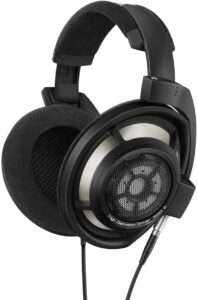
Sennheiser has built a name for itself as an industry leader in audio quality by producing headphones with precision engineering that reimagine what it means for sound to be clear and detailed.
The Sennheiser HD 800 S represents the company’s unwavering commitment to providing listeners with an experience that is incomparable to any other.
The HD 800 S emerges as a formidable competitor in the realm of headphones for mixing and mastering due to its exceptional soundstage, accuracy, and attention to detail. These aspects make it a standout product in the industry.
Features
- Open-back design for a spacious soundstage.
- Exceptional clarity and accurate representation of audio.
- Wide frequency response and low distortion.
- Comfortable for extended sessions.
- Ideal for critical listening and detailed work.
Pros
1. Unrivaled Soundstage:
The HD 800 S is celebrated for its expansive and immersive soundstage. It recreates a spacious sonic environment that allows you to perceive the placement of individual instruments and effects with unparalleled precision. This feature is instrumental in achieving a balanced mix and pinpointing subtle nuances.
2. Precise and Neutral Sound:
These headphones are engineered to provide an uncolored and neutral sound signature. The balanced frequency response ensures that you hear your audio content accurately, making it easier to identify irregularities, tonal imbalances, and imperfections within your mixes and masters.
3. Exceptional Clarity:
The HD 800 S boasts exceptional clarity, which is vital for critically analyzing audio. You’ll hear the finest details, enabling you to make precise adjustments that translate seamlessly across various listening environments.
4. Comfort for Extended Sessions:
Sennheiser’s ergonomic design philosophy shines through in the HD 800 S. The headphones are designed for prolonged use, incorporating plush ear cushions and an adjustable headband to ensure comfort even during marathon mixing or mastering sessions.
5. Audiophile-Grade Build Quality:
Crafted from premium materials, the HD 800 S exudes an air of luxury. Its high-quality build ensures durability, and the headphones are meticulously designed to minimize resonance and distortion, contributing to an authentic listening experience.
Cons
1. Premium Price Tag:
The HD 800 S is an investment in excellence. While the quality justifies the cost, the price might be prohibitive for those on tighter budgets.
2. Amplication Requirements:
These headphones shine with proper amplification. To unlock their full potential, you might need to invest in a dedicated headphone amplifier, adding to the overall cost.
3. Open-Back Design Limitations:
The open-back design that contributes to the exceptional soundstage also means that sound leakage occurs. This design might not be suitable for environments where noise isolation is a priority.
4. Bulky Design:
The HD 800 S is relatively large and might not fold for compact storage. This could pose challenges for portability if you need to transport them frequently.
2. Beyerdynamic DT 1990 Pro:
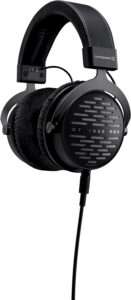
It is of the utmost importance, in the field of audio production, to realize a level of precision and accuracy in the sound. The exceptional reputation that the Beyerdynamic DT 1990 Pro headphones have earned for delivering audio quality that is suitable for professional use has attracted a lot of attention.
These headphones, which were designed with painstaking attention to detail, are tailored to the specific requirements of audio engineers, music producers, and music fans in general.
In this part of the review, we will delve into the benefits and drawbacks of the Beyerdynamic DT 1990 Pro, shedding light on the aspects that make them stand out as well as the areas in which they may have room for improvement.
Features
- Open-back design with replaceable ear pads for customization.
- Precise and balanced sound with detailed imaging.
- Adjustable headband for comfort.
- High build quality and durability.
- Comes with multiple cable options.
Pros
1. Exceptional Sound Clarity:
The DT 1990 Pro boasts a detailed and precise sound signature that allows you to dissect your audio with surgical precision. From the sparkling highs to the deep lows, every nuance is faithfully reproduced, making it a formidable tool for mixing and mastering tasks.
2. Removable Ear Pads for Customization:
One notable feature is the ability to switch between two sets of ear pads—analytical and balanced—allowing you to tailor the headphones’ sound profile to your specific needs. This adaptability is a unique offering, enabling you to fine-tune your listening experience.
3. Accurate Imaging and Soundstage:
With an open-back design, the DT 1990 Pro excels in creating a wide and immersive soundstage. The accurate imaging aids in placing sound elements precisely within the mix, contributing to an enhanced sense of depth and space.
4. High Build Quality and Comfort:
Crafted with premium materials, the headphones exude a sense of durability and sturdiness. The adjustable headband, coupled with plush ear cushions, ensures comfort during long hours of use—a critical aspect for professionals working on extended sessions.
5. Analytical and Detailed Listening:
The analytical nature of these headphones is well-suited for critical listening. They reveal subtleties in the audio that might otherwise go unnoticed, allowing you to make informed decisions about EQ, balance, and effects.
6. Multiple Cable Options:
The DT 1990 Pro comes with both coiled and straight cable options, providing flexibility for different use cases. Whether you’re moving around your studio or need a stationary setup, these cables accommodate your preferences.
Cons
1. Price Point:
The Beyerdynamic DT 1990 Pro falls within a higher price range, which might pose a challenge for those on a tighter budget. While the investment is justified by the exceptional quality, it’s important to consider the financial aspect.
2. Requirement for Adequate Amplification:
To fully unlock the potential of these headphones, they benefit from sufficient headphone amplification. This additional equipment might be necessary to achieve the desired sound quality and volume levels.
3. Audeze LCD-X:
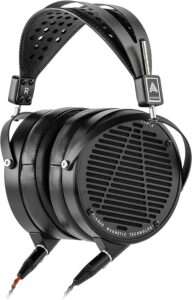
When it comes to headphones designed for audiophiles, the Audeze LCD-X is a model that exemplifies both excellent craftsmanship and pinpoint accuracy.
The LCD-X headphones are the result of Audeze’s commitment to pushing the limits of what is possible sonically. These headphones provide an immersive experience that is suited for both audio professionals and audio enthusiasts with discerning tastes.
The LCD-X headphones, which are renowned for their planar magnetic technology and their emphasis on accuracy, have earned a place among the leading contenders for critical listening, mixing, and mastering tasks.
Features
- Planar magnetic drivers for accurate and extended frequency response.
- Wide soundstage with excellent imaging.
- Premium build quality and materials.
- Suitable for both mixing and mastering tasks.
- Requires sufficient amplification for optimal performance.
Pros
1. Supreme Accuracy and Detail:
The standout feature of the Audeze LCD-X lies in its ability to deliver an exceptionally accurate and detailed representation of audio. Thanks to the planar magnetic drivers, the headphones excel in revealing subtle nuances that might be masked by other transducer technologies.
This level of precision empowers audio professionals to identify imperfections and make informed adjustments during the mixing and mastering process.
2. Wide Soundstage and Imaging:
The open-back design of the LCD-X contributes to a spacious and realistic soundstage. This wide presentation allows for accurate placement of sound elements within the sonic landscape, aiding in achieving a balanced mix.
The imaging is exceptionally clear, enabling users to perceive the direction and distance of each sound source within the mix.
3. Premium Build Quality and Comfort:
Crafted with premium materials, the LCD-X exudes a sense of luxury and durability. The comfortable suspension-style headband and plush ear pads ensure extended listening sessions without discomfort. The build quality is not only a testament to Audeze’s commitment to excellence but also adds to the overall professional experience.
4. Versatility for Mixing and Mastering:
The LCD-X’s balanced sound signature makes it suitable for both mixing and mastering tasks. Its neutral presentation allows users to analyze mixes accurately, while the precise imaging aids in making refined adjustments.
The headphones excel in delivering a transparent representation that can be critical in ensuring audio translates well across different listening environments.
Cons
1. Amplification Requirements:
The LCD-X has relatively high impedance and requires a quality headphone amplifier to unlock its full potential. This additional investment might be necessary to achieve the optimal sonic performance these headphones are capable of delivering.
2. Weight and Bulkiness:
While the premium build quality is admirable, the LCD-X can feel heavy during extended use. The bulkiness might not be suitable for users who prefer lightweight headphones for prolonged listening sessions.
3. Price Point:
The Audeze LCD-X falls within the higher price range of headphones. While its performance justifies the cost for many professionals, the investment might be steep for those on a tighter budget.
4. AKG K712 Pro:
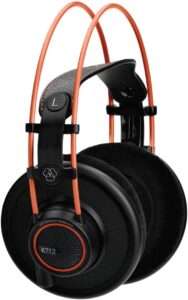
When it comes to the production of audio, precision and accuracy are of the utmost importance. Every sonic detail is important, and the tools you choose to use can have a significant impact on the final product.
When it comes to choosing headphones for essential processes like mixing and mastering, the AKG K712 Pro is an intriguing contender to consider.
Professionals and amateurs alike have taken notice of the K712 Pro due to the fact that it is well-known for both its balance and its performance.
In this section, we explore the benefits and drawbacks of the AKG K712 Pro headphones, providing insights into what makes them stand out and where they might be lacking.
Features
- Open-back design with spacious soundstage.
- Natural and balanced sound signature.
- Comfortable fit for long sessions.
- Affordable option with professional features.
- Ideal for discerning audio professionals on a budget.
Pros
- Natural Soundstage: The open-back design of the K712 Pro creates an expansive and natural soundstage. This characteristic helps audio professionals accurately perceive the placement of different elements within the mix, making it easier to achieve a balanced result.
- Balanced Sound Signature: These headphones are known for their balanced sound signature, providing a neutral representation of audio frequencies. This neutrality aids in identifying tonal imbalances and making precise adjustments to your mixes.
- Comfortable for Extended Sessions: The K712 Pro boasts a comfortable fit, featuring well-padded ear cups and an adjustable headband. This design ensures that you can work on your projects for extended periods without discomfort or fatigue.
- Professional Build Quality: Crafted with attention to detail, the AKG K712 Pro exhibits professional build quality. Durable materials and solid construction contribute to their longevity, making them a reliable tool for long-term use.
- Versatile Usage: While they excel in mixing and mastering, the K712 Pro headphones are versatile enough for various audio tasks. Whether you’re analyzing tracks, editing recordings, or simply enjoying high-quality audio, these headphones deliver.
- Precise Imaging: The headphones’ ability to reproduce accurate imaging allows you to distinguish between different sound sources and effects. This precision aids in crafting a well-balanced mix with distinct sonic elements.
Cons
- High Impedance: With an impedance of 62 ohms, the K712 Pro headphones may require a dedicated headphone amplifier to reach their full potential. Using them with devices that can’t provide sufficient power might result in suboptimal audio quality.
- Sound Leakage: Like many open-back headphones, the K712 Pro allows sound to leak in and out. While this design contributes to the natural soundstage, it might not be ideal for environments where noise isolation is crucial.
- Limited Portability: The open-back design and relatively large size make the K712 Pro less portable compared to closed-back or foldable headphones. They are best suited for stationary studio use rather than on-the-go applications.
5. Sony MDR-7506:
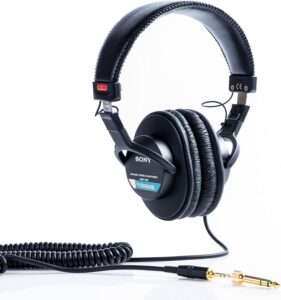
Sony is one of the few names in the field of audio production that is synonymous with both reliability and widespread recognition. The Sony MDR-7506 headphones have become a standard fixture in recording studios and sound booths all over the world because they have withstood the test of time.
The combination of their instantly recognizable appearance and a well-earned reputation for reliable operation has established them as the product of choice for both experienced users and novices.
In this part of the article, we delve into the benefits and drawbacks of the Sony MDR-7506 headphones, shedding light on the enduring appeal of these headphones as well as considerations for potential users.
Features
- Closed-back design with excellent isolation.
- Neutral sound signature for accurate representation.
- Lightweight and foldable for portability.
- Affordable option with a long-standing reputation.
- Ideal for those starting out in mixing and mastering.
Pros
- Accuracy and Flat Response: The MDR-7506 headphones are known for their relatively flat frequency response. This neutrality allows audio engineers to hear their mixes with minimal coloration, making it easier to identify tonal imbalances and frequency issues.
- Durability and Build Quality: Sony has crafted the MDR-7506 with durability in mind. These headphones are built to withstand the rigors of studio use, featuring a rugged construction that can handle daily wear and tear.
- Isolation and Sound Leakage: The closed-back design of the MDR-7506 offers good isolation, effectively blocking out ambient noise. Additionally, they minimize sound leakage, ensuring that your audio stays contained within the headphones.
- Affordability: The Sony MDR-7506 headphones provide professional-grade features at a relatively affordable price point. This accessibility has made them an attractive option for those seeking quality on a budget.
- Portability and Folding Design: The headphones are designed with portability in mind. They can be folded into a compact form, making them easy to transport between studio sessions or on-the-go.
Cons
- Comfort for Extended Use: While the headphones offer comfort for shorter sessions, some users find that extended wear can lead to discomfort due to the design of the headband and ear cushions.
- Bass Response: The MDR-7506 has a relatively modest bass response compared to some other models. This can be a drawback for genres that heavily rely on deep bass tones.
- Limited Soundstage: The closed-back design contributes to a narrower soundstage compared to open-back headphones. This might impact the perception of spatial placement within the mix.
- Cable Length: The coiled cable, while helpful for preventing tangling, might be considered too long for some users’ preferences, potentially limiting mobility.
Additional Tips for Successful Mixing and Mastering
More than just having the right headphones is required for successful mixing and mastering. Here are some additional tips to help you improve your workflow and achieve exceptional results:
1. Make use of reference tracks:
Reference tracks are songs that have been professionally mixed and mastered and can be used as a benchmark. A/B comparing your mix to a reference track allows you to identify problem areas and achieve a more balanced sound.
2. Establish a Reliable Listening Environment:
Install acoustic treatment in your workspace to reduce reflections and resonances. This ensures that the sound you hear through your headphones is an accurate representation of your mix.
3. Dual-Monitoring Method:
While headphones are essential, they should not be relied on solely. Use studio monitors in conjunction with headphones to gain a more complete understanding of the sonic characteristics of your mix.
4. Take Rest Periods:
Prolonged listening sessions can cause ear fatigue and poor judgment. Take frequent breaks to rest your ears and avoid making decisions based on faulty hearing.
5. Get to Know Your Headphones:
Spend some time getting to know your new headphones. Recognize their strengths and weaknesses, as well as any frequency biases they may have. This understanding allows you to compensate when mixing and mastering.
6. Mix at a lower volume:
Lowering the volume reduces ear fatigue and allows you to concentrate on balance and tonal accuracy. It also prevents certain elements from being overemphasized due to excessive volume.
7. Use Several Pairs of Headphones:
While having a high-quality pair of headphones is essential, checking your mix on different headphones (even consumer-grade ones) on a regular basis can reveal issues that are not visible on your primary headphones.
8. Pay Attention to Your Ears, Not Just the Numbers:
While technical specifications are important, your most valuable tool is your ears. Listen critically and trust your judgment rather than relying solely on graphs and numbers.
9. Prevent Overprocessing:
Because mixing/mastering headphones are so accurate, it’s easy to overdo processing. Make subtle changes that translate well across different playback systems.
10. Continue Your Education:
The world of audio production is constantly changing. Continue to learn about new techniques, tools, and trends in order to improve your skills and stay current.
Conclusion
You are now prepared to make an informed decision based on your production goals and personal preferences, having gained knowledge from this guide.
Your headphones will be a constant companion on your musical journey, whether you’re engineering complex mixes or putting the finishing touches on a masterful track. Here’s to making music that crosses boundaries and speaks to your listeners’ hearts. Good luck with your mixing and mastering!
Frequently asked questions
Q1: Can’t I just use regular consumer headphones for mixing and mastering?
While consumer headphones are great for casual listening, they often emphasize certain frequencies to enhance the listening experience. Mixing and mastering headphones are designed to provide a neutral and accurate representation of sound, enabling you to make precise adjustments to your mixes and masters.
Q2: What’s the difference between open-back and closed-back headphones for mixing and mastering?
Open-back headphones offer a more natural soundstage and wider sense of space, making them ideal for critical listening. However, they might leak sound and provide less isolation. Closed-back headphones offer better isolation and prevent sound leakage but may have a slightly narrower soundstage.
Q3: Are more expensive headphones always better for mixing and mastering?
Price doesn’t necessarily determine quality. Expensive headphones often offer superior build, sound, and comfort, but there are excellent options in various price ranges. The key is to find headphones that meet your specific needs and preferences while maintaining a balanced budget.




